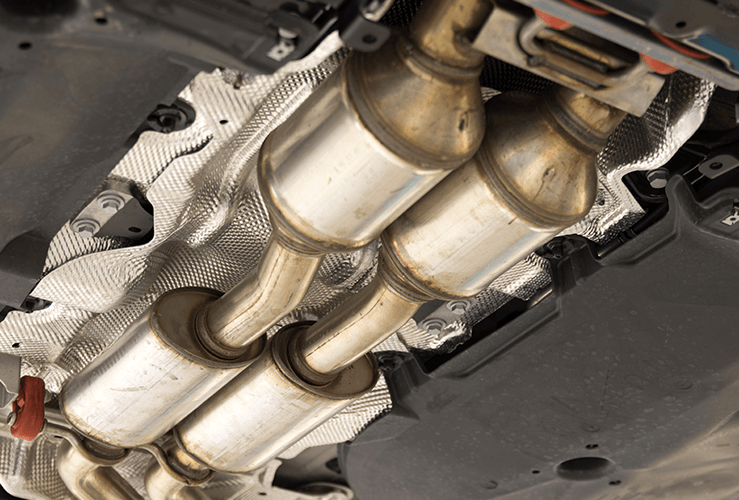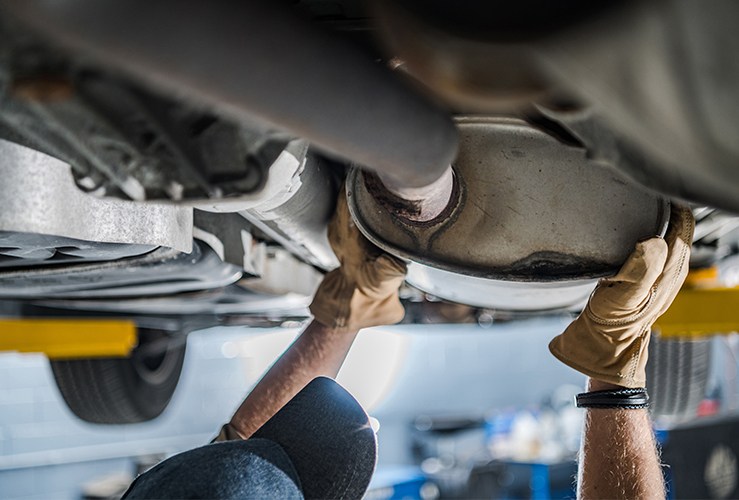What is a catalytic converter? Why is it so important? How do you know if yours needs to be repaired or replaced? Here’s all you need to know about this essential component.
Combustion engine vehicles emit harmful pollutants into the environment, namely nitrogen (NOx) oxides, carbon monoxide (CO), and hydrocarbons (HC). Catalytic converters transform most of these into less harmful particles, although around 10% of harmful particles are still released.
Why Do Cars Need a Catalytic Converter?
Since 1993, all new UK-built cars have been legally required to have a catalytic converter installed before it can be sold to the public.
If your vehicle does not have a catalytic converter installed, it will fail its next MOT (assuming the tester spots it). That said, if your vehicle was built before 1993 and didn't have a cat in the first place, it won't fail an MOT if it doesn't have one.
Petrol Engine Catalytic Converter
A petrol engine catalytic converter contains a ceramic honeycomb monolith that allows free airflow and maximal surface area. The multiple interior pathways are coated with up to three precious metals, including palladium, platinum, and rhodium.
As the exhaust heats up to around 300 degrees Celsius, the surrounding matting expands, creating the required pressure to hold the monolith in place. The NOx, CO, and HC particles then undergo a chemical reaction as they come into contact with the precious metals, transforming them into less harmful gases - namely carbon dioxide (CO2), nitrogen (N2), and water (H2O).
There are two catalysts in the catalytic converter. The gases first pass through a 'reduction catalyst', followed by an 'oxidation catalyst'.
Do Diesel Engines Have Catalytic Converters?
Yes. A diesel engine catalytic converter works in a similar way but also features a diesel particulate filter (DPF), which works to trap and burn off harmful particulates. DPFs help diesel engines meet today's strict emissions standards.
Diesel 'cats' operate at lower temperatures than their petrol engine counterparts and need to 'regenerate' - i.e. burn off accumulated soot particles. This may work as 'passive regeneration' - whereby the regeneration process occurs while the vehicle is being driven - or 'active regeneration', which requires additional heat.
Diesel engines emit more NOx than petrol units and higher levels of particulate matter overall. The different combustion characteristics require slightly different technologies to help reduce harmful emissions, but both have the same objective: to render exhaust fumes less harmful to humans and the environment in general.
Where Would You Find a Catalytic Converter?
Your car’s catalytic converter is located in the exhaust system, towards the front.
How Long Do Catalytic Converters Last For?
Catalytic converters last around 10 years, although this can vary based on things like engine tune and mileage. Ideally, your cat should be checked once every 50,000 miles (every six years or so).
What Causes Catalytic Converter Problems?
Catalytic converters can malfunction when the following three problems occur:
Overheated, Melted, or Broken Converters:
- A catalytic converter can be subject to temperatures higher than it was designed for if a malfunction leads to increased hydrocarbons or CO (together with O2).
- These malfunctions include misfires, low compression, poor spark or no spark, excessive vehicle load, AFR cylinder imbalance, worn-out O2 sensors, or problems with the fuel delivery system.
- A petrol-engine catalytic converter can handle temperatures of around 300 degrees Celsius, but a malfunction can increase this temperature to 850 degrees Celsius or more, which can melt critical components.
The Honeycomb Pathways Become Coated in Oil/Grime:
- The converter will be less efficient if the honeycomb pathways become coated in substances such as coolant, certain gasket sealants, burnt oil carbon buildup, or the wrong fuel.
Structural Damage:
- Converters can stop working properly if they suffer corrosion, stress fractures, thermal shock, O2 sensor thread damage, flex pipe issues, or an air-gap pipe failure.
Signs My Catalytic Converter is Broken
A clogged catalytic converter may be accompanied by the following warning signs:
- Sluggish performance
- Reduced acceleration
- Sulfuric smell from the exhaust
- Dark exhaust smoke
- Excessive heat coming from under the vehicle
You may also see the ‘check engine light’ appear on your dashboard, or, in some cars, a specific catalytic converter warning light, which comprises smoke waves rising from a catalytic converter - in yellow or amber.
Catalytic Converter Repair Cost
It may be possible to repair a catalytic converter if the damage is in the early stages, but in most cases, you would need to buy a catalytic converter replacement.
How Much is a Catalytic Converter?
The cost of a new catalytic converter can vary depending on the make and model of your car. As a rough guide, you should expect to pay between £150 and £500 - although a luxury or sports car 'cat' can cost in excess of £1000.

Why Does a Catalytic Converter Cost So Much?
For a catalytic converter to capture and convert harmful pollutants, its honeycomb pathways must be coated in certain precious metals, namely platinum, palladium, and rhodium, all of which are very expensive. At the time of writing, platinum costs £23 per gram, palladium £25, and rhodium £133.
Is This Why Thieves Steal Catalytic Converters?
Yes, the value of the precious metals in a catalytic converter makes them of great interest to criminals. Additionally, a catalytic converter can be removed in a matter of minutes.
How Can I Prevent the Theft of My Catalytic Converter?
- Buy a catalytic converter lock or guard.
- Park in a garage or a well-lit area.
- Mark your cat with a forensic marker, which will make it more difficult for thieves to sell on.
Find out more information on how to prevent catalytic converter theft.

How Harmful Are Nitrogen Oxide (NOx) Particles?
NOx is a precursor for ozone, which can inflame the respiratory tracts, eyes, nose, and throat. It can also cause asthma attacks.
How Harmful Are Hydrocarbon (HC) Particles?
Prolonged exposure to hydrocarbons is thought to increase the risk of cancer, respiratory problems, and heart disease. HCs also pollute air and water and absorb sunlight, thereby impacting climate change. Hydrocarbons can also reduce visibility, particularly in urban areas.
How Harmful Are Carbon Dioxide (CO2) Particles?
While CO2 particles themselves are not directly harmful to humans, they contribute to the 'greenhouse' effect, trapping heat in the Earth's atmosphere, leading to higher temperatures, rising sea levels, and disrupted ecosystems.







